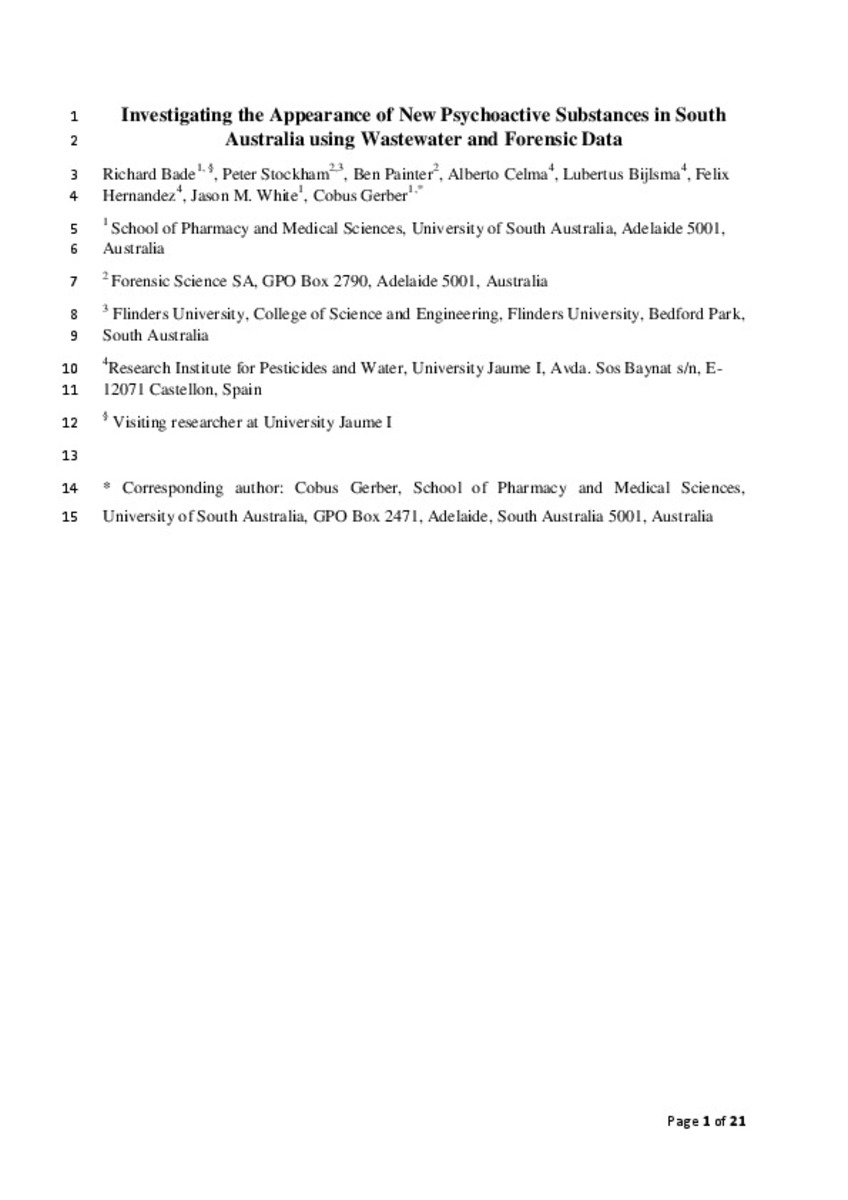Mostrar el registro sencillo del ítem
Investigating the appearance of new psychoactive substances in South Australia using wastewater and forensic data.
| dc.contributor.author | Bade, Richard | |
| dc.contributor.author | Stockham, Peter | |
| dc.contributor.author | Painter, Ben | |
| dc.contributor.author | Celma, Alberto | |
| dc.contributor.author | Bijlsma, Lubertus | |
| dc.contributor.author | Hernandez, Felix | |
| dc.contributor.author | White, Jason | |
| dc.contributor.author | Gerber, Cobus | |
| dc.date.accessioned | 2019-02-12T10:47:45Z | |
| dc.date.available | 2019-02-12T10:47:45Z | |
| dc.date.issued | 2018-08-20 | |
| dc.identifier.citation | BADE, Richard; STOCKHAM, Peter; PAINTER, Ben; CELMA TIRADO, Alberto; BIJLSMA, Lubertus; HERNÁNDEZ HERNÁNDEZ, Félix; WHITE, Jason M.; GERBER, Cobus (2018). Investigating the appearance of new psychoactive substances in South Australia using wastewater and forensic data. Drug Testing and Analysis, online 20/8/2018 | ca_CA |
| dc.identifier.uri | http://hdl.handle.net/10234/180982 | |
| dc.description.abstract | New psychoactive substances (NPS) have increased in use and popularity worldwide. Wastewater analysis has been successfully applied to evaluate illicit drugs use within a population. However, for NPS, such an approach may be limited due to low doses of NPS combined with their ever‐changing composition and usage. The dynamic nature of the NPS market means use may be opportunistic, infrequent, and with few users. Hence, the use of complementary information sources is recommended to improve the knowledge on NPS consumption. The aim of this study was to investigate the changing landscape of NPS use on a community scale by combining wastewater analysis and forensic toxicology. Forensic analysis provided specific information on NPS prevalence in post‐mortem blood samples in Adelaide, South Australia over five years, while wastewater analysis showed community use over the same period. A qualitative liquid chromatography–‐high resolution mass spectrometry method was initially used to screen the wastewater samples. A total of 24 NPS were found: 6 in wastewater only, 13 in forensic post‐mortem toxicology samples only, and 5 in both. As these results showed the presence of NPS, a targeted method was subsequently employed to quantify levels of these NPS in wastewater. Temporal trends were found in wastewater with distinct tendencies for synthetic cathinones visible over the period studied. | ca_CA |
| dc.format.extent | 21 p. | ca_CA |
| dc.format.mimetype | application/pdf | ca_CA |
| dc.language.iso | eng | ca_CA |
| dc.publisher | Wiley | ca_CA |
| dc.relation.isPartOf | Drug Testing and Analysis (2018), online 20/8/2018 | ca_CA |
| dc.rights.uri | http://rightsstatements.org/vocab/CNE/1.0/ | * |
| dc.subject | Synthetic cathinones | ca_CA |
| dc.subject | High resolution mass spectrometry | ca_CA |
| dc.subject | Triple quadrupole | ca_CA |
| dc.subject | 35 Wastewater | ca_CA |
| dc.subject | Forensic toxicology | ca_CA |
| dc.title | Investigating the appearance of new psychoactive substances in South Australia using wastewater and forensic data. | ca_CA |
| dc.type | info:eu-repo/semantics/article | ca_CA |
| dc.identifier.doi | https://doi.org/10.1002/dta.2484 | |
| dc.relation.projectID | 1) SA Health, Generalitat Valenciana. Grant Number: Prometeo II 2014/023; 2) Spanish Ministry of Economy and Competitiveness. Grant Number: CTQ2015‐65603. | ca_CA |
| dc.rights.accessRights | info:eu-repo/semantics/openAccess | ca_CA |
| dc.relation.publisherVersion | https://onlinelibrary.wiley.com/doi/full/10.1002/dta.2484 | ca_CA |
| dc.contributor.funder | 1) Thyne Reid Foundation; 2) University of South Australia; 3) Early Career Researcher International Travel Grant | ca_CA |
| dc.type.version | info:eu-repo/semantics/publishedVersion | ca_CA |
Ficheros en el ítem
Este ítem aparece en la(s) siguiente(s) colección(ones)
-
IUPA_Articles [307]







